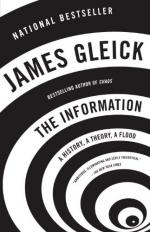
|
| Name: _________________________ | Period: ___________________ |
This test consists of 5 multiple choice questions, 5 short answer questions, and 10 short essay questions.
Multiple Choice Questions
1. In what manner was "A Table Alphabeticall" arranged?
(a) Alphabetically.
(b) By frequency of use.
(c) By importance.
(d) By popularity.
2. In what field was Charles Babbage an early pioneer?
(a) Advanced mathematics.
(b) Computer science.
(c) Physics.
(d) Astronomy.
3. What was the goal of James Murray when he wrote the first Oxford English Dictionary in 1879?
(a) To catalog the entire English language.
(b) To limit the work to only proper English.
(c) To alphabetize all words.
(d) To provide the pronunciation of all words.
4. What society created the first numeric tables?
(a) Chinese.
(b) Egyptian.
(c) Babylonian.
(d) Roman.
5. In his graduate paper, to what did Claude Shannon apply the binary logic of George Boole?
(a) To a system of relays.
(b) To an advanced telegraph.
(c) To a logarithm table.
(d) To circuit grid.
Short Answer Questions
1. What culture grouped characters in categories such as tools, weapons, plants, animals, and buildings?
2. Why did businessmen immediately take to the telegraph?
3. What did Alan Turing reduce human thought to?
4. How did the telegraph advance weather forecasting?
5. Shannon proposed a solution for overcoming extra noise in his communication model that mimicked what early communicators?
Short Essay Questions
1. Who first conceived the idea of a machine that could think and under what circumstances?
2. How did the development of the written language assist Greek philosophers in advancing mankind?
3. Who invented the "first" telegraph?
4. What advanced form of communication was beginning to emerge in the 1840s?
5. After the use of pictures, what were the next two stages of language development?
6. Who developed the Principia Mathematica and what did it provide?
7. While working on plans for this "analytical engine," Babbage struck an acquaintance with what young woman?
8. Why did Ada Lovelace publish her mathematical arguments anonymously?
9. While Shannon worked on secret cryptography projects for the US government during World War II, what theory about information did he conceive?
10. Who invented the telegraph and what is its fundamental functionality?
|
This section contains 729 words (approx. 3 pages at 300 words per page) |

|




